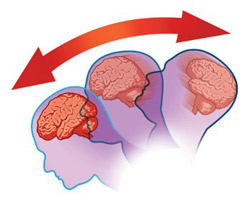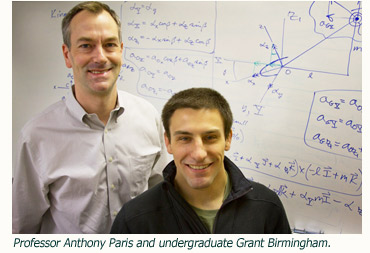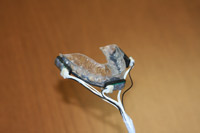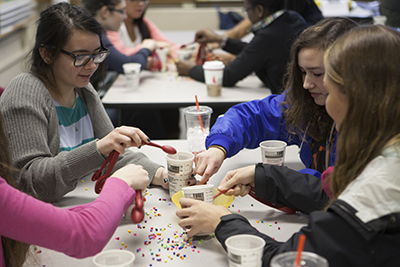UAA mouth guard may provide insight into concussions
by Kathleen McCoy |
 A shadow darkened Super Bowl Sunday this year - the growing evidence of brain damage
from professional football.
A shadow darkened Super Bowl Sunday this year - the growing evidence of brain damage
from professional football.
High-profile cases get headlines. Super Bowl champ Dave Duerson shot himself in the chest two years ago at age 50, asking that his brain be donated to science to determine what an NFL career did to it.
Anchorage has had its own headline. In 2010, a flag football player suffered a severe concussion after she ran into a pillar. After months of rehabilitation, she asked to address a local coaches' clinic on the hazards of head injury.
"There's just not enough information on (the brain)" Lexi Stewart told the Anchorage Daily News. "The doctor we saw didn't know. The emergency room didn't know. How's a coach supposed to know? How's a parent supposed to know?"
Lexi Stewart is right. While there are plenty of statistics about emergency room visits from sports- and recreation-related brain injury among children and adolescents (almost 175,000 annually, up 60 percent over the past decade), there is very little information about what actually happens to the brain when it takes a hit.
The tools to measure that impact simply don't exist. With pressure in both professional and amateur sports, and the recent experiences of soldiers exposed to IED explosives in the Middle East, the rush is on to close this information gap.
Scientists talk about these impacts to the head as accelerations. They can be linear (back and forth, up and down) or angular (spinning, as when the head whips back and the chin comes up).
Some testing has been done measuring impact on helmets. But since the upper jaw is part of the skull, the mouth turns out to be a much better source of data.
 Three engineers at UAA, Anthony Paris, Jennifer Brock and John Lund, along with several
undergraduates, are working hard to evolve a mouth guard with sophisticated instruments
for measuring these forces. The university has a patent pending on a bridge with just
six tiny accelerometer chips to measure impact to the head. This bridge is embedded
in an acrylic mouth guard modeled to snuggly fit a wearer's teeth and gums.
Three engineers at UAA, Anthony Paris, Jennifer Brock and John Lund, along with several
undergraduates, are working hard to evolve a mouth guard with sophisticated instruments
for measuring these forces. The university has a patent pending on a bridge with just
six tiny accelerometer chips to measure impact to the head. This bridge is embedded
in an acrylic mouth guard modeled to snuggly fit a wearer's teeth and gums.
The challenges they face are getting accurate measurements, capturing and wirelessly transmitting the data, and then developing useful information about brain injury from it.
"If a kid skateboarding in the street hits his head on the curb, how do you know what happened? How do you treat him?" Paris asks.
If that skateboarder was wearing an instrumented mouth guard, an EMT could download the data on the way to the hospital. Over time doctors would develop a database for effective treatment of head trauma.
Paris' first prototype, dating back to about 2004, was a simple model with one chip embedded in a blob of acrylic-primitive, but capable of gathering data.
Next, the team found off-the-shelf sensors developed for detecting unwanted vibration in rotating machinery-perhaps a sign that a bearing was going. They stuck three of these, each about the size of a sugar cube, onto a mouth guard. Recording and transmitting equipment were also embedded.
The result was a little like seeing someone who'd shoved too many hot dogs in their mouth during an eating contest. Still, they were able to use this version for early testing. Employing a local high school athlete, they gathered information and high-speed video as she headed soccer balls.
"We got beautiful data," Paris said, "data that no one has ever seen before."
While the engineering worked, the design needed innovation; tinkering continued.
 Lund, an electrical engineer, replaced the chunky "sugar cubes" by building his own
tiny integrated circuit boards. The number of sensors dropped from nine (three in
each of the cubes) to six after they realized careful placement netted the same quality
data. Lund soldered the chips side-by-side horizontally instead of vertically, lessening
the mouth guard's height for an easier fit
Lund, an electrical engineer, replaced the chunky "sugar cubes" by building his own
tiny integrated circuit boards. The number of sensors dropped from nine (three in
each of the cubes) to six after they realized careful placement netted the same quality
data. Lund soldered the chips side-by-side horizontally instead of vertically, lessening
the mouth guard's height for an easier fit
Their data begin to illuminate impacts to the brain. Engineers measure linear acceleration in Gs (acceleration triggered by gravity) and angular acceleration in radians per second squared. Gravity causes a free falling object to drop at 1 G and a record turntable accelerates at 3.49 radians per second squared.
Now consider a soccer ball moving at 27 mph hitting a player's head. Their mouth guard measured linear accelerations at about 28 Gs and angular accelerations of 3,900 radians per second squared.
That same test measured a maximum force at impact of 236 pounds lasting 15 milliseconds-a short duration but a large force.
"Is that important?" asks Paris. "No one knows. No one has done the work."
Now polishing their fifth prototype with yet another still-secret innovation in mind, the team is growing confident that a quip John Lund made one day will indeed come true:
"In 20 years, no one's going to be putting a dumb piece of plastic in their mouth."
NOTE: A version of this story also ran in the Anchorage Daily News.
 "UAA mouth guard may provide insight into concussions" is licensed under a Creative Commons Attribution-NonCommercial 4.0 International License.
"UAA mouth guard may provide insight into concussions" is licensed under a Creative Commons Attribution-NonCommercial 4.0 International License.














